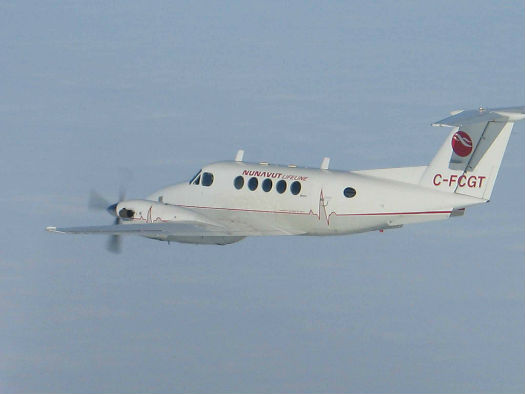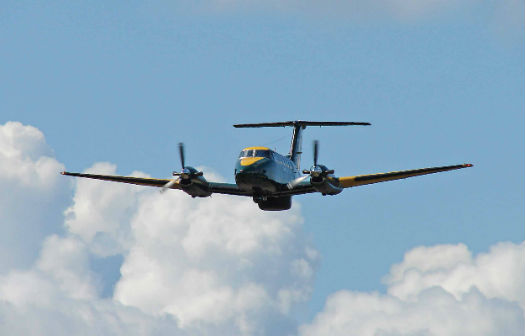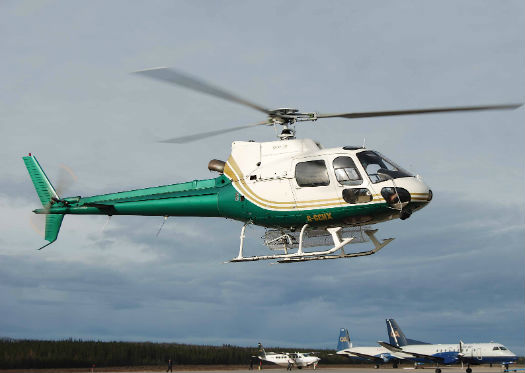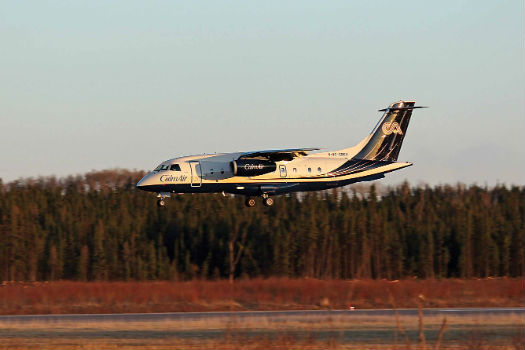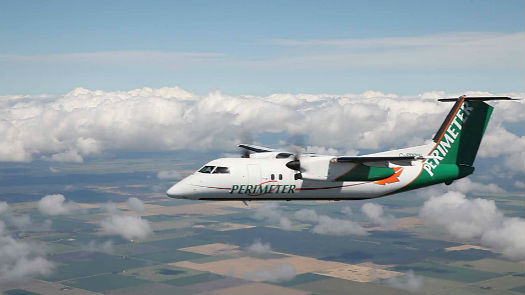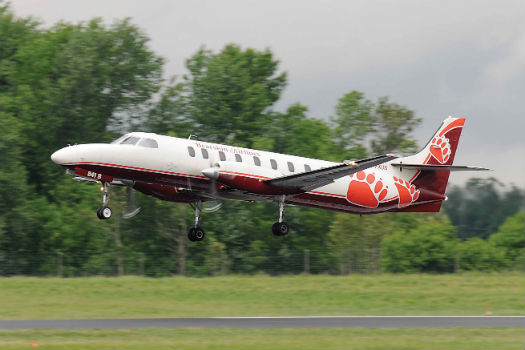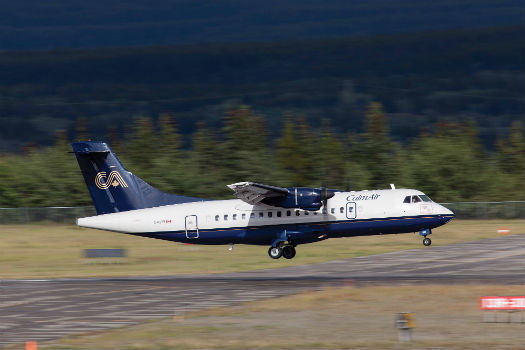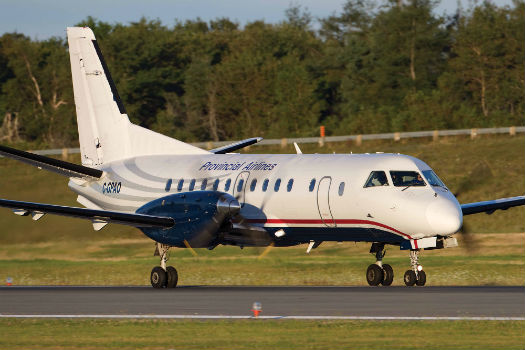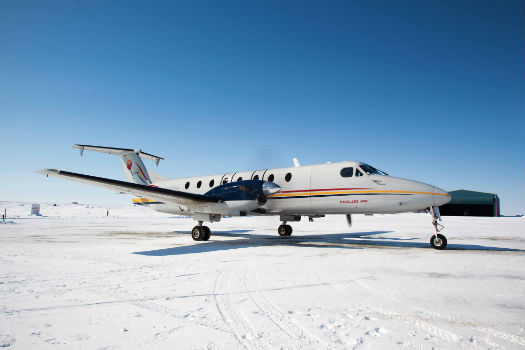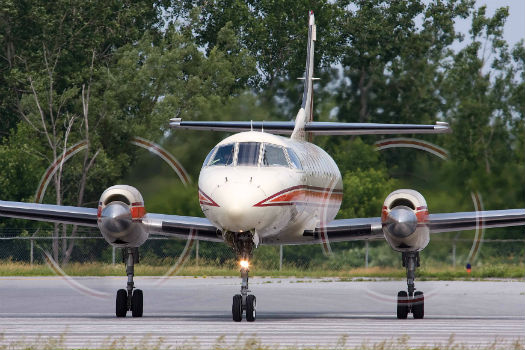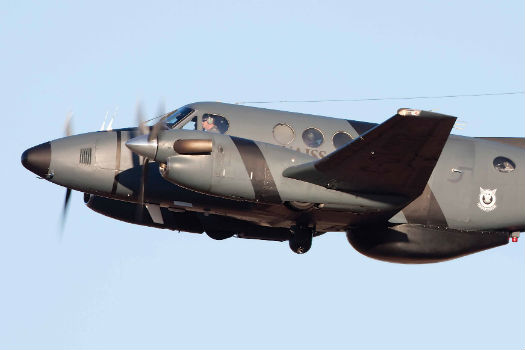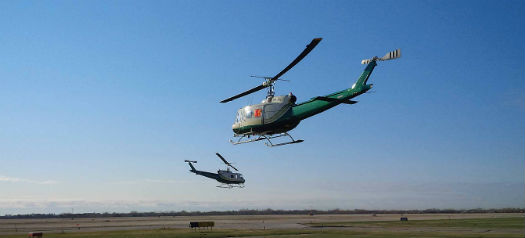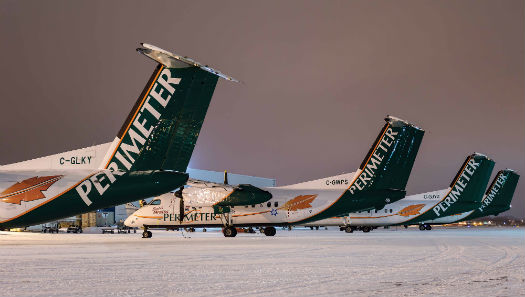About 120 aircraft in Canada are flown by EIC’s six commercial aviation companies, including single- and twin-engine turboprops, jets and helicopters. This Keewatin Air Pilatus PC-12 air ambulance serves remote communities with short runways in the Baffin Region of Nunavut. Jason Pineau Photo
Aviation companies make good investments.
That’s what Exchange Income Corporation (EIC) has demonstrated in the years since the Winnipeg investment company purchased its first airline in 2004.
While EIC executives are the first to say they run an investment company, not an aviation business, the growth of the corporation’s seven aviation businesses is becoming too big to ignore.
Most recently, EIC entered into an agreement in mid-November 2014 to purchase the PAL Group of Companies (PAL) of St. John’s, N.L., for $246 million. The deal includes three operating divisions–Provincial Aerospace, Provincial Airlines and PAL Aviation Services–employing 26 aircraft and approximately 900 people in Canada and around the world.
Keewatin Air King Air 200s fly for Nunavut Lifeline. Keewatin Air Photo
The purchase of the PAL Group is the largest acquisition in EIC’s history and ranks as the biggest aviation acquisition in Canada since IMP Group bought Cascade Aerospace of Abbotsford, B.C., in 2012.
With annual revenues of $185 million, the PAL Group is one of Atlantic Canada’s largest aviation employers, and an internationally recognized leader in the design, installation, modification and operation of maritime surveillance aircraft. The purchase was successfully closed on Jan. 2, 2015.
Provincial Aerospace’s King Air 200 maritime patrol aircraft. Provincial Aerospace Photo
BY THE NUMBERS
Many working in the aviation industry are surprised to learn that EIC owns Canada’s second-largest fleet of commercial aircraft, after Air Canada.
Its fleet of 160 aircraft range in size from Bell JetRanger helicopters to ATR 72 turboprops and Bombardier CRJ700 regional jets.
About 120 of these aircraft wear the colour schemes of six commercial operators: Perimeter Aviation, Keewatin Air, Calm Air, Bearskin Airlines, Custom Helicopters, and Provincial Airlines. They provide various services to customers in more than 60 communities, most in northern Canada.
An additional 40 regional jet and turboprop aircraft are owned by Regional One in Miami, Fla., some of which are leased to airlines on five continents.
In 2013, EIC’s revenues reached $1 billion for the first time, thanks to the acquisition of Regional One and the organic growth of its cellular tower installation business in the United States, which was sold for a profit in October 2014 for US$200 million.
EIC’s aviation segment reported revenues of $313 million in 2013. With the addition of the PAL Group in 2015, the company’s aviation revenues should grow to between $500 and $600 million.
Custom Helicopters’ Airbus AS350BA AStar. Custom Helicopters Photo
INCOME TRUST
Exchange Industrial Income Group Inc. (as first named) was created in 2002, to capitalize on the surging demand for income trusts as tax efficient yield investments as interest rates declined.
“Our original plan was to own a portfolio of well-established manufacturing companies,” explained Mike Pyle, CEO of Exchange Income Corporation. “But we had a major setback when the value of the Canadian dollar increased rapidly in 2002 and 2003. Shifting exchange rates made it very difficult to determine if an export manufacturer was profitable.
“One day, I was playing golf with a banking colleague and described our challenge finding profitable manufacturing companies to buy that had consistent revenue, consistent income and good cash flow.
“That’s when my friend turned to me and said, ‘That sounds like our company; you should have a look at it.’ He was the CFO of Perimeter Aviation.”
Calm Air’s Fairchild-Dornier 328-300 passenger jet. Calm Air Photo
Pyle was skeptical that a regional airline had all the attributes required to launch the income trust, “but we quickly discovered that Perimeter was a terrific candidate.”
He added that EIC has become very disciplined about its purchases, focusing on buying the right company at the right price. “Most of the companies we’ve acquired are 45- to 60-year-old privately held businesses in stable niche markets that can grow with the availability of new capital. We don’t acquire distressed companies and turn them around; that’s not our business model.”
Perimeter Airways’ Bombardier Dash 8-100. Perimeter Photo
PERIMETER AVIATION
In March 2004, EIC bought Perimeter Aviation from founder William Wehrle for $17.2 million, selling the first trust units for $8 in a public offering.
Founded in 1961, Perimeter flew 18 Fairchild Metro II and Metro III turboprops on scheduled routes serving northern First Nations communities; two Metro IIs on air ambulance charters; and five twin-engine piston aircraft (Beech Barons and Travel Airs) for multi-engine IFR pilot training.
EIC brought in the Tribal Councils Investment Group of Manitoba Ltd. (TCIG) as an early investor (active until 2012), and launched a joint marketing program to increase sales in First Nations communities. Since these communities account for a large part of EIC’s current business in Manitoba, Labrador and Nunavut, the income trust has always emphasized partnership programs that give back to the First Nations and Inuit communities it serves.
Bearskin Airlines’ Fairchild Metro 23. Eric Dummigan Photo
Perimeter became the template for EIC’s future growth. Leadership focuses on generating steady, dependable distributions for shareholders and finding the right acquisitions, while the business unit manager capitalizes on opportunities for organic growth.
“One year after Perimeter was purchased, our biggest competitor (Skyward Aviation) shut down, which created an immediate opportunity to double the size of our company,” recalled Nick Vodden, now president of Perimeter.
With EIC’s financial support, Perimeter added five Metro IIIs; expanded the medevac fleet of Metros IIs; bought Skyward’s cargo and maintenance facilities in Thompson, Man., and Rankin Inlet, Nunavut; and initiated Bombardier Dash 8 service to large communities on a trial basis, using a wet-leased aircraft.
Perimeter further expanded in 2006, when it obtained a CAR 705 operating certificate to operate larger aircraft, and purchased its first Dash 8s.
Revenues nearly tripled from $27 million to $84 million between 2004 and 2013, as the fleet grew from 24 to 33 aircraft, including five Dash 8 turboprops (three Dash 8-100s and two Dash 8-300s) that were outfitted with moveable bulkheads to carry various combinations of passengers and freight.
In September 2014, Perimeter received Transport Canada certification for the installation of a new Garmin 950/1000 glass cockpit in the Metro III, which had been a 26-month development program.
The new design saves weight, increases aircraft reliability and, most importantly, enhances safety, providing the Perimeter Metro III fleet with enhanced capabilities.
Features include synthetic vision for enhanced situational awareness (enabling a computerized view of the ground and obstacles while flying in cloud or at night); built-in onscreen navigational charts; traffic collision avoidance system (TCAS); terrain avoidance warning system (TAWS); weather radar; global positioning system (GPS); and live in-flight weather updates.
Perimeter now operates a fleet of 31 aircraft, including three Beechcraft Barons, seven Metro IIIs, 16 Metro IIs and five Dash 8s for scheduled and charter services.
Since 2008, Calm Air International has renewed its fleet with the addition of eight ATR42s in combi configuration (pictured), and four ATR72 combi and all-cargo turboprop aircraft. Jason Pineau Photo
KEEWATIN AIR
In June 2005, EIC bought a second aviation company when it acquired Keewatin Air Ltd. from its founders, Bob May and Judy Saxby.
Founded in Rankin Inlet in 1971, Keewatin Air began air ambulance service with dedicated aircraft in the early 1980s, hiring its own flight nurses and registered respiratory therapists a few years later.
Keewatin Air had revenues of $15 million. It flew three medically-configured Beechcraft King Air 200s to nine remote communities under the trade name Nunavut Lifeline, and three Pilatus PC-12s on scheduled flights (carrying medical patients) under the trade name Kivalliq Air.
“With the support of EIC, we bought two twin-engine, 19-seat Beech 1900Cs to replace our leased nine-seat PC-12s,” recalled Wayne McLeod, president of Keewatin Air. “This gave us more seating capacity, a common fleet of Beech aircraft, and a twin-engine aircraft better suited to long distance charter work and contracts.
“Then, in 2010, we doubled the size of our business when we won a five-year contract to provide air ambulance service to 12 communities in the Baffin Region of Eastern Nunavut on a 24-hour basis.”
Provincial Airlines is transitioning to an all Dash 8 fleet, replacing two Saab 340s with a Dash 8-100 and Dash 8-300. Michael Durning Photo
To meet the requirements of the contract, Keewatin Air built a 20,000-square-foot hangar at Iqaluit Airport and added two King Air 200s, two Learjet 35As and a Pilatus PC-12 to its fleet. Employment also doubled to 140 people to crew the new contract.
“Our Learjet 35s fly patients from Iqaluit to southern hospitals in Winnipeg and Ottawa, and the PC-12 was required to serve the short airstrips at Grise Fjord and Kimmirut,” said McLeod. “I don’t believe we could have expanded our fleet and built a new base in Iqaluit without EIC’s support.”
Perimeter and Keewatin operate in separate markets with very little overlap, with the two acquisitions expanding the geographic coverage of the combined entity.
Keewatin Air’s two Beech 1900Cs fly medical patients and charters in Nunavut and northern Manitoba. Jason Pineau Photo
CALM AIR INTERNATIONAL
Carl Arnold Lawrence Morberg founded Calm Air to fly guests to a fishing camp in northern Saskatchewan in 1962 (and used his initials – CALM – to name the airline). The airline moved to Manitoba in 1969, added DHC-6 Twin Otters and Hawker Siddeley HS748s in the 1970s and 1980s, and in 1995 added its first Saab 340B turboprops.
“We softly approached the Morberg family about buying Calm Air after Arnold died in 2005, but they had no desire to sell,” recalled Calm Air president Gary Bell, previously EIC’s director of acquisitions. “Four years later, the family sold Calm Air when they recognized that the cost of revitalizing the fleet was between $20 to $40 million.”
Added EIC’s Mike Pyle: “The acquisition of Calm Air was a major growth step for our company, because it cost almost $60 million at a time when we only had revenues of about $60 million. We completed the acquisition in April 2009, with the support of capital markets during the world economic crisis.”
Based out of Thompson, Man., Calm Air serves 16 communities from its primary hubs in Winnipeg and Churchill, Man., as well as Rankin Inlet, Nunavut, reinforcing EIC’s position as a dominant regional carrier in Manitoba and central Nunavut.
Since 2009, EIC has provided the capital Calm Air required to introduce 14 pre-owned aircraft into the fleet: two Dornier 328-300 jets, eight ATR 42s and four ATR 72 turboprops.
Combined, Perimeter and Bearskin operate a fleet of 40 Metro II/ III/23 turboprops for schedule passenger and aeromedical service in northern Manitoba and Ontario. Michael Durning Photo
“We replaced our Saab 340B turboprops with ATR 42s and our HS 748 freighters with ATR 72s,” said Bell. “Our last HS 748 freighter will retire when we receive our last ATR 72, which will have an oversized cargo door.”
Almost all of Calm Air’s scheduled routes have transitioned to combi ATR 42 and ATR 72 service, “which allows our passenger business to subsidize our cargo business, and our cargo business to subsidize our passenger business on the same flight,” added Bell.
The one exception are flights between Nunavut and Winnipeg, serviced by two 30-seat Dornier 328-300 jets introduced in 2012 to cut flight times. Two of the ATR 72s are also in all-cargo configuration to serve high demand routes and to transport fuel to remote communities using bladder tanks.
EIC also provided Calm Air with the capital to build a new 60,000-square-foot hangar at Winnipeg International Airport, and five 4,000-square-foot airport warehouses (with fridges and freezers) in northern communities with the highest cargo volumes in Garden Hill, Oxford House, Rankin Inlet, Arviat, and Baker Lake.
“Historically, our flights were scheduled to arrive in northern communities during the day, so we could deliver food and cargo to our customers during regular business hours,” said Bell.
“The new warehouses allow us to deliver cargo 24 hours a day, which helps us to increase the utilization of our aircraft and our efficiency as an airline.”
EIC’s presence in Nunavut was recently strengthened by a long-term strategic alliance agreement with Sakku Investments Corporation, the business arm of the Kivalliq Inuit Association, which was previously aligned with First Air.
Provincial Aerospace is a design, installation, and modification facility, and an operator of maritime surveillance and special mission aircraft. Four Beechcraft King Air 200s are contracted by the Government of Canada, and another flies seasonal iceberg patrols for the offshore oil industry off Newfoundland and Labrador. Michael Durning Photo
DIVERSIFICATION
Between 2005 and 2008, EIC diversified its portfolio by acquiring four specialty manufacturing businesses: Jasper Tank, Overlanders, Water Blast Group and Stainless Fabrication.
During 2009, EIC completed its conversion from an income trust structure to a publically listed corporation (ticker EIF) trading on the Toronto Stock Exchange.
Then, in 2011, EIC bought Westower Communications, which quickly won a three-year contract from AT&T, worth more than $500 million, to install and maintain cellular towers.
BEARSKIN AIRLINES
In January 2011, EIC expanded its geographic market area with the purchase of Ontario’s Bearskin Airlines for $32.5 million.
Founded as Bearskin Lake Air Service in 1963, the regional airline operated 14 Fairchild Metro III and Metro 23 turboprops on 100 daily scheduled flights. It serviced 14 communities in Ontario and three in Manitoba, generating revenues of $50 million in 2010.
In 2003, Bearskin had sold its northwestern Ontario bush flying business to Wasaya Airlines, as it refocused on serving passengers travelling between Thunder Bay, Sault Ste. Marie, Sudbury, North Bay, Kapuskasing, and Timmins.
With the encouragement of the Region of Waterloo International Airport, Bearskin introduced the first non-stop commuter flights between Kitchener/Waterloo and Ottawa, bypassing Toronto’s Pearson Airport.
“As I got older, I wondered how I would retire,” said Bearskin Airlines president Harvey Friesen during a 2013 interview with Skies, prior to his death in early 2014. “I never envisioned that a company [EIC] would come along and buy us out, lock stock and barrel.”
As a result of increased airline competition in its Eastern Ontario markets, Bearskin later rationalized its route network in April 2014, by terminating service between Ottawa and Kitchener and adjusting service levels on other routes.
Custom Helicopters’ medium lift fleet includes three Bell 205A-1s. Custom Helicopters Photo
CUSTOM HELICOPTERS
Exchange Income Corp. made its first investment in the commercial helicopter industry in February 2012, when it acquired Custom Helicopters Manitoba’s largest helicopter operator, Custom was founded in 1977.
In 2012, Custom operated 24 helicopters and had five maintenance bases located at Winnipeg (St. Andrews), Thompson, Gilliam and Garden Hill in Manitoba, and Rankin Inlet in Nunavut. The company has long- and short-term contracts with government agencies, utilities, First Nations groups, mining companies and other customers.
“Many of the companies in the aviation group share the same customers, suppliers and certain facilities,” said Custom president Brian Hawes. “And all the companies work closely with First Nations and Inuit communities in the North.”
In March 2012, Custom Helicopters and MKO (Manitoba Keewatinowi Okimakanak Inc.) created Piminawin Ltd. as a joint venture to give MKO’s 30 First Nation Bands in northern Manitoba an opportunity to participate in the helicopter market.
EIC has achieved other cost savings through the coordinated purchase of aviation fuel and insurance.
REGIONAL ONE
In April 2013, EIC branched out into the regional aircraft and engine leasing and spare parts business when it acquired Regional One of Miami, Fla.
Regional One was founded in 2004 by Doron Marom, a former Volvo Aero executive turned entrepreneur, when he seized the opportunity to establish a company committed to the support of the turboprop market. At the time, Volvo Aero had made a long-term commitment to the large commercial aircraft and engine parts distribution business.
Regional One started life leasing de Havilland Canada Dash 7 and British Aerospace ATP turboprops and selling engines and parts.
“We identified an opportunity in 2012 to buy in-production aircraft being phased out of tier one regional airlines,” said Hank Gibson, president of Regional One, and a former executive with Volvo Aero. “We needed capital to take advantage of the opportunity, and a friend who leases Fairchild Metro aircraft suggested we talk to Exchange Income Corporation.”
Provincial Aerospace flies air ambulance aircraft contracts with the governments of Nova Scotia (King Air 200, pictured) and Newfoundland and Labrador (Cessna 550). Provincial Aerospace Photo
After a short courtship, EIC bought Regional One for $89.9 million, the largest acquisition in its history at the time.
Over the past five years, Regional One has had an annual average growth rate of 25 per cent, with its portfolio totaling 40 owned aircraft by late 2014.
The timing of the Regional One acquisition also helped offset a decline in EIC’s rapidly growing but low margin $600-million cellular tower installation business.
“Our aircraft and parts business is driven by aircraft fleet movements,” explained Gibson. “Aircraft transitioning out of the fleet of a first tier airline will typically get fragmented among multiple operators, who will take one or two aircraft each.
“Intimate asset and technical knowledge is critical as we execute our strategy to lease, trade and part-out airframes and engines; timing is everything. As the portfolio manager we maintain advanced analysis on each of the aircraft and engines in our portfolio. Detailed technical analysis from scheduled maintenance events to modifications and service bulletins are the basis for forecasting the future value and disposition of our portfolio.”
Gibson added that Regional One has been growing organically since it was purchased by EIC, including the purchase of 14 70-seat Bombardier CRJ 700 regional jets. The company is in the process of purchasing two CRJ700s currently on lease to Air India Regional, and in October 2014 it agreed to buy 12 CRJ 700s retiring from Lufthansa CityLine.
Some of the CRJ 700s will be “flyers” marketed to other airlines, and others will be broken up to support Regional One’s engine leasing and spare parts business.
The company’s portfolio also includes one of the world’s largest inventories of GE CF34 turbofan engines and P&WC PW100 turboprops, and an ownership/management interest in nearly 30 Bombardier CRJ 200s. The portfolio also includes a fleet of turboprop aircraft and parts for Dash 7s, Dash 8s, ATPs and 15 ATR 42/72s.
Four of Perimeter Aviation’s five Bombardier Dash 8s parked on Christmas Eve 2014 at Winnipeg’s James A. Richardson International Airport. Matthew Capina Photo
PAL GROUP
The PAL Group was founded in 1972, commenced scheduled airline operations in 1980, established an airborne maritime surveillance division in the 1980s (originally known as Atlantic Airways), and in 1988 acquired Eastern Flying Service (founded in 1955) and its bases in Halifax and Sydney, N.S.
“Our company has grown in steps, with each step requiring a large capital investment,” said PAL Group CEO Brian Chafe. “After spending more than 30 years building the company, our owners believed it was the right time to sell.”
Provincial Airlines is the largest independent regional airline based in Atlantic Canada. It serves 19 destinations in Newfoundland and Labrador, New Brunswick, Nova Scotia, and Quebec, with a fleet of six Dash 8s (three Dash 8-100s and three Dash 8-300s) two Saab 340s and one Fairchild Metro.
The first Saab 340s were introduced in 2001 to expand passenger service to Quebec and Labrador, and the first Dash 8 added in 2004 to support the Vale Inco mine at Voisey’s Bay.
“Our airline passenger business has increased by about 300 to 400 per cent in the past eight years,” commented Chafe. “Our primary focus is serving industrial customers (such as mines and hydroelectric projects) with a combination of scheduled flights and charters.”
Under new ownership, Provincial Airlines will be transitioning to an all-Dash 8 fleet, adding a Dash 8-100 and Dash 8-300 to replace its Saab aircraft.
Provincial Airlines also holds a 49 per cent interest in Innu Mikun Airlines of Goose Bay, in partnership with the Innu First Nations of Labrador. The partnership, which operates five DHC-6 Twin Otters, was recently extended for an additional 15 years to 2035.
Provincial Aerospace is an internationally recognized leader in the maritime surveillance aircraft market, with ongoing contracts in Canada, the Caribbean and the Middle East.
“About 85 per cent of our aerospace business is the design, installation, modification and operation of maritime surveillance and special mission aircraft, with up to four aircraft in our modification hangar at any one time,” said Chafe.
Provincial Aerospace’s maritime surveillance fleet includes four Beechcraft King Air 200s contracted by the Government of Canada; one King Air 200 performing iceberg patrols from January to June for the offshore oil and gas industry; and two highly modified Dash 8-100s contracted by the Netherlands government for the Dutch Caribbean Coast Guard air reconnaissance operations.
In 2009, PAL won a $370-million contract to be the prime contractor providing the United Arab Emirates (UAE) with two highly-modified Dash Q300 maritime patrol aircraft, with PAL also providing ongoing post-delivery training and maintenance in Abu Dhabi.
Other business lines include air ambulance contracts with the governments of Nova Scotia (King Air 200) and Newfoundland and Labrador (Cessna 550).
Provincial Aerospace also partnered with Airbus Defence and Space to offer the Airbus C295 turboprop for Canada’s long delayed fixed-wing search-and-rescue aircraft program.
Exchange Income Corporation didn’t start life as an aviation business, but aviation companies now form a significant part of its investment portfolio. A policy of selective acquisition has paid great dividends for EIC shareholders, while providing seven well-established aviation operations with the opportunity for further growth. In addition, new business partnerships are being created as EIC companies find more ways to work with each other.
CEO Mike Pyle indicated that EIC continues to look at other aviation acquisitions, but he could not say when it will buy its next company.
“In every business sector there are winners and losers, so it’s very important to pick the right company,” he concluded.
Ken Swartz is an award-winning aerospace industry journalist who has covered the market for more than 25 years. He has spent most of his career as an international marketing and media relations manager with airlines and one of the largest commercial aircraft manufacturers. He runs Aeromedia Communications, an aerospace marketing and PR agency, and can be reached at kennethswartz@me.com.

